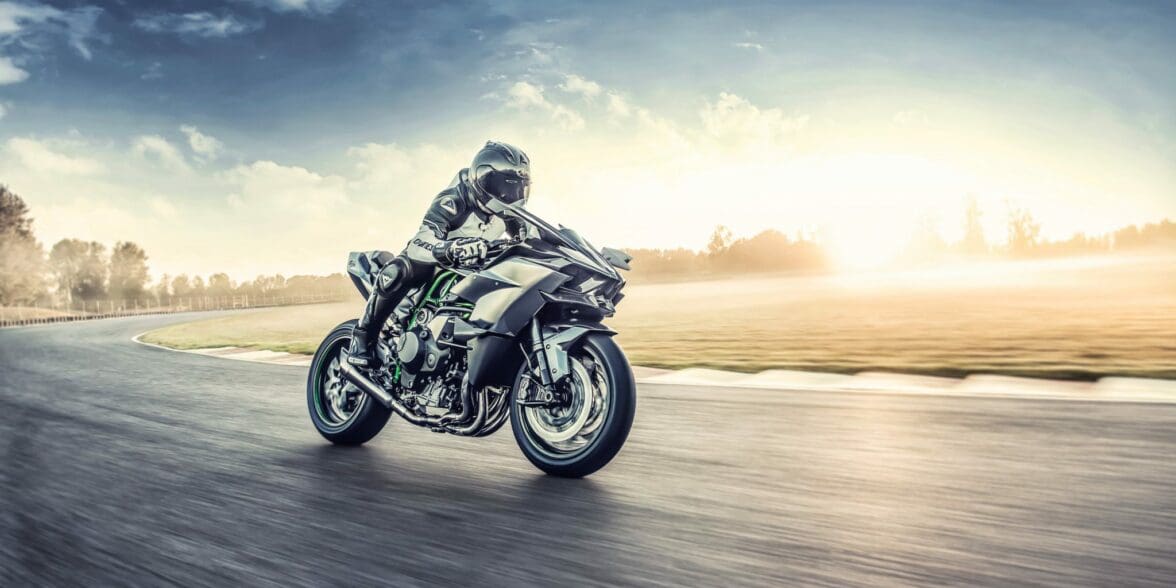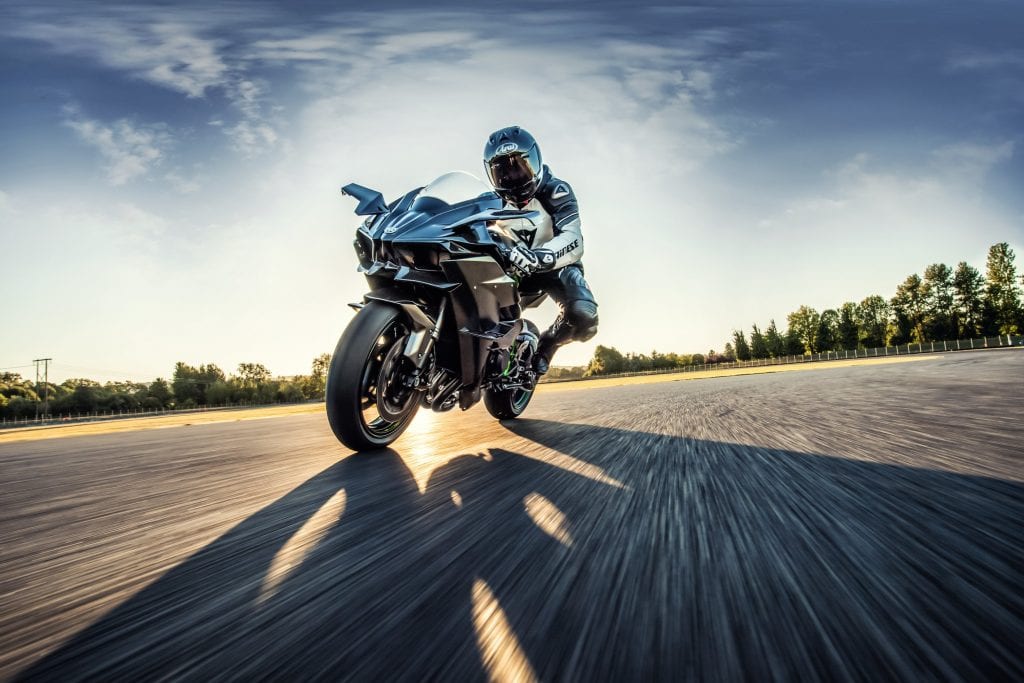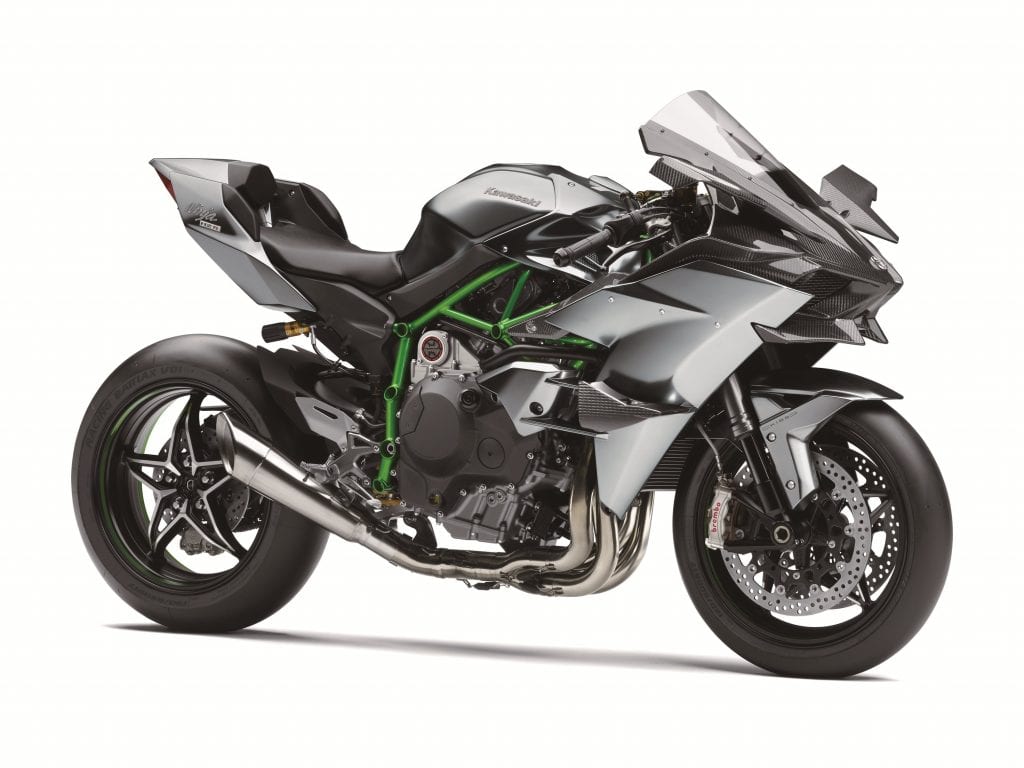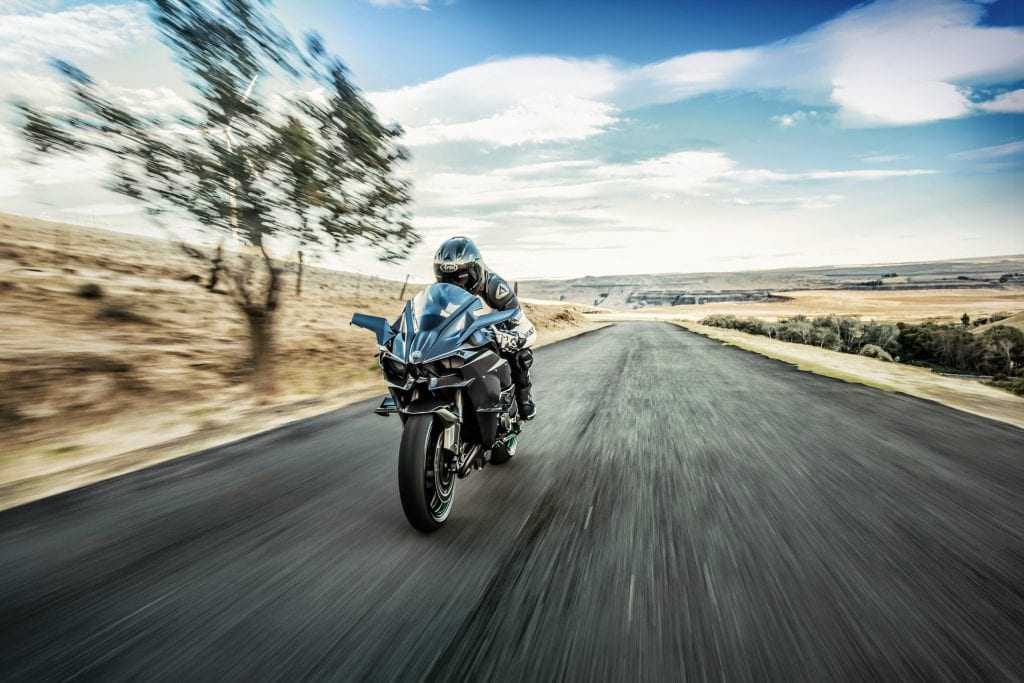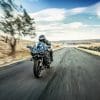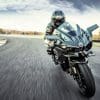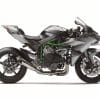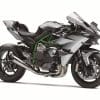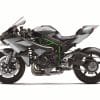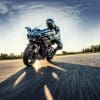2020 Kawasaki Ninja H2R
Contents
The 2020 Ninja H2R is quite literally the most powerful supersport motorcycle to ever emerge from Kawasaki. It is also the most powerful motorcycle in the entirety of the 2020 model year, across all manufacturers. It is the first of what many enthusiasts (and even manufacturers themselves) are calling hypersport bikes, due to the fact that it produces 310 crank HP and 115 lbs-ft of crank torque from a supercharged 998cc inline 4 in a motorcycle that has a full wet weight of only 476 lbs.
We have kept the H2R separate from the 2020 H2 for the reason that the H2R is not street legal, due to the fact that it uses Kawasaki racing derived components, does not have mirrors, indicators, and uses racing slick tires. Apart from that, the H2R uses an extremely strong welded steel trellis frame along with multiple carbon fiber fairings, and even winglets on the front of the bike near the handlebars and aerodynamic deflectors in front of the knees.
Another interesting fact of the H2R is that it currently holds the unofficial top speed record for factory stock motorcycles, at 250 MPH (or 400 KM/H), set using a 2016 version of the bike in Turkey.
The 2020 Kawasaki Ninja H2R starts at $55,000 US/$61,200 CA
On this page: we’ve curated specs, features, news, photos/videos, etc. so you can read up on the new Kawasaki Ninja H2R in one place.
Model Overview
General Info
- Price: $55,000 US/$61,200 CA
- Key Features:
- Abs (Anti-lock Brake System)
- Supercharged Engine
- LED Lighting
Key Specs
- Engine type: 998cc, 4-stroke, 4-cylinder
- Power: 310 Hp
- Wet weight: 476.3 lb
- Seat height: 32.7 in
Key Competitors
- BMW HP4 Race
- Ducati Panigale R
- Aprilia RSV4 R Factory
2020 Kawasaki Ninja H2R Specifications
ENGINE |
||
| Engine | 998cc, 4-stroke, 4-cylinder, DOHC, 4-valve, liquid-cooled, supercharged | |
| Power | 310 Hp | |
| Bore x Stroke | 76.0mm x 55.0mm | |
| Compression Ratio | 8.3:1 | |
| Fuel System | DFI® with 50mm throttle bodies (4) with dual injection | |
| Starter | Electric | |
| Lubrication | Forced lubrication, wet sump with oil cooler | |
DRIVETRAIN |
||
| Clutch | Wet multi-disc, manual | |
| Transmission | 6-speed, return, dog-ring | |
| Final Drive | Sealed chain | |
CHASSIS |
||
| Suspension Front | 43mm inverted fork with adjustable rebound and compression damping, spring preload adjustability and top-out springs/4.7 in | |
| Suspension Rear | Uni-Trak®, hlins TTX36 gas charged shock with piggyback reservoir, 30-way compression and rebound damping and adjustability, and hand-turn spring preload adjustability and top-out spring/5.3 in | |
| Brakes Front | Dual radial-mount, opposed 4-piston M50 calipers, dual semi-floating 330mm discs, KIBS ABS | |
| Brakes Rear |
Opposed 2-piston calipers, single 250mm disc, KIBS ABS
|
|
| Tires Front | 120/60 ZR17 Bridgestone V01F slick | |
| Tires Rear | 190/65 ZR17 Bridgestone V01R slick | |
| Fuel Tank Capacity | 17 L (4.5 US gal.) | |
| Color | Mirror Coated Matte Spark Black | |
ELECTRICAL |
||
| Ignition | TCBI with digital advance | |
| Spark Plugs | ||
| Headlight | LED | |
| Tail Light | LED | |
DIMENSIONS |
||
| Overall Length | 82.5 in (2070 mm) | |
| Overall Width | 33.5 in (850 mm) | |
| Overall Height | 45.7 in (1,160 mm) | |
| Wheelbase | 57.3 in (1,455 mm) | |
| Ground Clearance | 5.1 in (130 mm) | |
| Seat Height | 32.7 in (830 mm) | |
| Curb Weight | 476.3 lbs (216 kg) | |
WARRANTY |
||
| Warranty | N/A | |
| Extension | ||
2020 Kawasaki Ninja H2R Features
Economical Riding Indicator
Using high-precision electronic control for engine management, Kawasaki models can achieve a high level of fuel efficiency. However, fuel consumption is greatly affected by throttle use, gear selection, and other elements under the rider’s control. The Economical Riding Indicator is a function that indicates when current riding conditions are consuming a low amount of fuel. The system continuously monitors fuel consumption, regardless of vehicle speed, engine speed, throttle position and other riding conditions. When fuel consumption is low for a given speed (i.e. fuel efficiency is high), an “ECO” mark appears on the instrument panel’s LCD screen. By riding so that the “ECO” mark remains on, fuel consumption can be reduced.
While effective vehicle speed and engine speed may vary by model, paying attention to conditions that cause the “ECO” mark to appear can help riders improve their fuel efficiency – a handy way to increase cruising range. Further, keeping fuel consumption low also helps minimize negative impact on the environment.
Electronic Throttle Valves
Electronic throttle valves also enable more precise control of electronic engine management systems like S-KTRC and KTRC, and allow the implementation of electronic systems like KLCM, Kawasaki Engine Brake Control, and Electronic Cruise Control.
Kawasaki Engine Brake Control
Kcmf (Kawasaki Cornering Management Function)
• S-KTRC/KTRC (including traction management and wheel lift management)
• KLCM (including traction management and wheel lift management)
– Designed to optimize acceleration from a stop
• KIBS (including pitching management and corner braking management)
• Kawasaki Engine Brake Control
Klcm (Kawasaki Launch Control Mode)
Designed to assist riders by optimizing acceleration from a stop, KLCM electronically manages engine output to minimize wheel spin when moving off. With the clutch lever pulled in and the system activated, engine speed is limited to a determined speed while the rider holds the throttle open. Once the rider releases the clutch lever to engage the clutch, engine speed is allowed to increase, but power is regulated to minimize wheel spin and help keep the front wheel on the ground. The system disengages automatically once a predetermined speed has been reached, or when the rider shifts into third gear. Depending on the model, riders can choose from multiple modes, each offering a progressively greater level of intrusion.
Kqs (Kawasaki Quick Shifter)
Designed to help riders maximize their acceleration on the track by enabling clutchless upshifts with the throttle fully open, KQS detects that the shift lever has been actuated and sends a signal to the ECU to cut ignition so that the next gear can be engaged without having to use the clutch. On models that offer clutchless downshifts, during deceleration the system automatically controls engine speed so that the next lower gear can be selected without operating the clutch.
Ktrc (Kawasaki Traction Control)
KTRC, Kawasaki’s advanced traction control system provides both enhanced sport riding performance and the peace of mind to negotiate slippery surfaces with confidence. Multiple rider-selectable modes (the number of modes varies by model) offer progressively greater levels of intrusion to suit the riding situation and rider preference.
Less intrusive modes maintain optimum traction during cornering. Designed with sport riding in mind, they facilitate acceleration out of corners by maximizing forward drive from the rear wheel. And because Kawasaki’s sophisticated software bases its dynamic analysis on the chassis’ orientation relative to the track surface (rather than relative to a horizontal plane), it is able to take into account corner camber, gradient, etc., and adapt accordingly.
In the more intrusive modes (and for some models, in any mode), when excessive wheel spin is detected, engine output is reduced to allow grip to be regained, effectively enabling riders to negotiate both short, slippery patches (train tracks or manhole covers) and extended stretches of bad roads (wet pavement, cobblestone, gravel) with confidence.
Models equipped with IMU incorporate chassis-orientation feedback to offer even more precise management.
Supercharged Engine
Drawing on the know-how and technology possessed by the Kawasaki Heavy Industries, Ltd. (KHI), Kawasaki’s supercharged engine delivers high engine output while maintaining a compact design. The key to achieving this incredible performance lies in the engine’s supercharger – a motorcycle-specific unit designed completely in-house with technology from the Kawasaki Gas Turbine & Machinery Company, Aerospace Company and Corporate Technology Division.
One of the greatest benefits of designing the supercharger in-house and tailoring its design to match the engine’s characteristics was that engineers were able to achieve high-efficiency operation over a wide range of conditions – something that would not have been possible by simply dropping in or trying to adapt an aftermarket automotive supercharger.
The importance of high efficiency in a supercharger is that, as the air is compressed, power-robbing heat gain is minimal. And while many superchargers are able to offer high-efficiency operation in a very limited range of conditions, the Kawasaki supercharger offers high efficiency over a wide range of pressure ratios and flow rates – meaning over a wide range of engine speeds and vehicle speeds. This wide range of efficient operation (similar to having a wide power band) easily translates to strong acceleration. The supercharger’s high efficiency and minimal heat gain also meant that an intercooler was unnecessary, greatly saving weight and space, and enabling the engine’s compact design.
ABS (Anti-lock Brake System)
Kawasaki ABS systems use front and rear wheel sensors to constantly monitor wheel speed. Should information from either of the sensors indicate that wheel lock has occurred, the ABS ECU directs the pump in the ABS unit to modulate brake fluid pressure (releasing and reapplying pressure so that traction can be regained) until normal operation resumes. ABS offers rider reassurance that contributes to greater riding enjoyment.
Ergo-fit®
Proper fit is key for rider comfort and control. However, the ideal fit varies from rider to rider, depending on their physical dimensions and riding style.
ERGO-FIT® is an interface system designed to allow riders to find their ideal riding position. Various points of the chassis interface (the handlebar, footpegs and seat, etc.) can be adjusted through a combination of interchangeable parts and parts with adjustable positions. This enables a wide range of riders to find a riding position that offers both comfort and control. Feeling at one with their machine, they will be able to experience how Kawasaki machines are fun and rewarding to ride.
*Adjustable parts and their range of adjustability vary by model.
Imu-enhanced Chassis Orientation Awareness
The strength of Kawasaki’s cutting-edge electronics has always been the highly sophisticated programming that, using minimal hardware, gives the ECU an accurate real-time picture of what the chassis is doing. Kawasaki’s proprietary dynamic modeling program makes skillful use of the magic formula tire model as it examines changes in multiple parameters, enabling it to take into account changing road and tire conditions.
The addition of an IMU (Inertial Measurement Unit) enables inertia along 6 DOF (degrees of freedom) to be monitored. Acceleration along longitudinal, transverse and vertical axes, plus roll rate and pitch rate are measured. The yaw rate is calculated by the ECU using Kawasaki original software. This additional feedback contributes to an even clearer real-time picture of chassis orientation, enabling even more precise management for control at the limit.
With the addition of the IMU and the latest evolution of Kawasaki’s advanced modeling software, Kawasaki’s electronic engine and chassis management technology takes the step to the next level – changing from setting-type and reaction-type systems to feedback-type systems – to deliver even greater levels of riding excitement.
KIBS (Kawasaki Intelligent Anti-lock Brake System)
Kawasaki developed KIBS to take into account the particular handling characteristics of supersport motorcycles, ensuring highly efficient braking with minimal intrusion during sport riding. It is the first mass-production brake system to link the ABS ECU (Electronic Control Unit) and engine ECU.
In addition to front and rear wheel speed, KIBS monitors front brake caliper hydraulic pressure, throttle position, engine speed, clutch actuation and gear position. This diverse information is analyzed to determine the ideal front brake hydraulic pressure. Through precise control, hydraulic pressure is modulated in much smaller increments than with standard ABS systems. The system limits rear wheel lift under heavy braking and takes downshifting into account while braking, allowing the rider to manage the rear brake. And because of the finer control, kickback to the brake lever is minimal, resulting in a very natural feeling.
Silver-mirror Paint
Kawasaki’s high-quality original paint has a highly reflective, glasslike metal appearance. Its debut on the 2015 Ninja H2™ and Ninja H2™R marked its first use on a mass-production vehicle in either the automotive or motorcycle industry.
In the shade the paint has the appearance of its base coat color, but once in the sunlight its highly reflective surface takes on the appearance of the surrounding scenery. The stark difference in the way the paint appears in the light and the shade emphasizes the sculpted shape of the bodywork on which it is applied.
The highly reflective surface is created by inducing a silver mirror reaction (a chemical reaction between a solution of silver ions and a reducing agent) that forms a layer of pure silver (Ag). This Ag layer is what creates the paint’s glasslike metal appearance. Compared to candy paints, which use aluminum flakes to generate a sparkling effect, the Ag layer appears as a uniform metallic surface.
In the shade the Ag layer is translucent, allowing the base coat color to show through. This gives the paint a deep, three-dimensional quality.
While the multiple layers of paint on typical mass-production models are done by robot painters, for this silver-mirror paint each layer – from primer to clear coat – is carefully finished by the hands of Kawasaki craftsmen to ensure a flawless, lustrous surface.
2020 Kawasaki Ninja H2R Photos
2020 Kawasaki Ninja H2R Videos
Links
Kawasaki Official Websites


